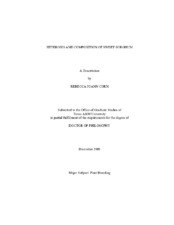| dc.description.abstract | Sweet sorghum (Sorghum bicolor) has potential as a bioenergy feedstock due to
its high yield potential and the production of simple sugars for fermentation. Sweet
sorghum cultivars are typically tall, high biomass types with juicy stalks and high sugar
concentration. These sorghums can be harvested, milled, and fermented to ethanol using
technology similar to that used to process sugarcane. Sweet sorghum has advantages in
that it can be planted by seed with traditional planters, is an annual plant that quickly
produces a crop and fits well in crop rotations, and it is a very water-use efficient crop.
Processing sweet sorghum is capital intensive, but it could fit into areas where sugarcane
is already produced. Sweet sorghum could be timed to harvest and supply the sugar mill
during the off season when sugarcane is not being processed, be fit into crop rotations, or
used in water limiting environments. In these ways, sweet sorghum could be used to
produce ethanol in the Southern U.S and other tropical and subtropical environments.
Traditionally, sweet sorghum has been grown as a pureline cultivar. However,
these cultivars produce low quantities of seed and are often too tall for efficient
mechanical harvest. Sweet sorghum hybrids that use grain-type seed parents with high sugar concentrations are one way to overcome limitation to seed supply and to capture
the benefits of heterosis.
There are four objectives of this research. First to evaluate the importance of
genotype, environment, and genotype-by-environment interaction effects on the sweet
sorghum yield and composition. The second objective is to determine the presence and
magnitude of heterosis effects for traits related to sugar production in sweet sorghum.
Next: to study the ability of sweet sorghum hybrids and cultivars to produce a ratoon
crop and determine the contribution of ratoon crops to total sugar yield. The final
objective is to evaluate variation in composition of sweet sorghum juice and biomass.
Sweet sorghum hybrids, grain-type sweet seed parents, and traditional cultivars
that served as male parents were evaluated in multi-environment trials in Weslaco,
College Station, and Halfway, Texas in 2007 and 2008. Both genotype and environment
influenced performance, but environment had a greater effect than genotype on the
composition of sweet sorghum juice and biomass yield. In comparing performance, elite
hybrids produced fresh biomass and sugar yields similar to the traditional cultivars while
overcoming the seed production limitations. High parent heterosis was expressed among
the experimental hybrids for biomass yield, sugar yield and sugar concentration.
Additional selection for combining ability would further enhance yields and heterosis in
the same hybrid. Little variation was observed among hybrids for juice and biomass
composition suggesting that breeding efforts should focus on yield before altering plant
composition. | en |


